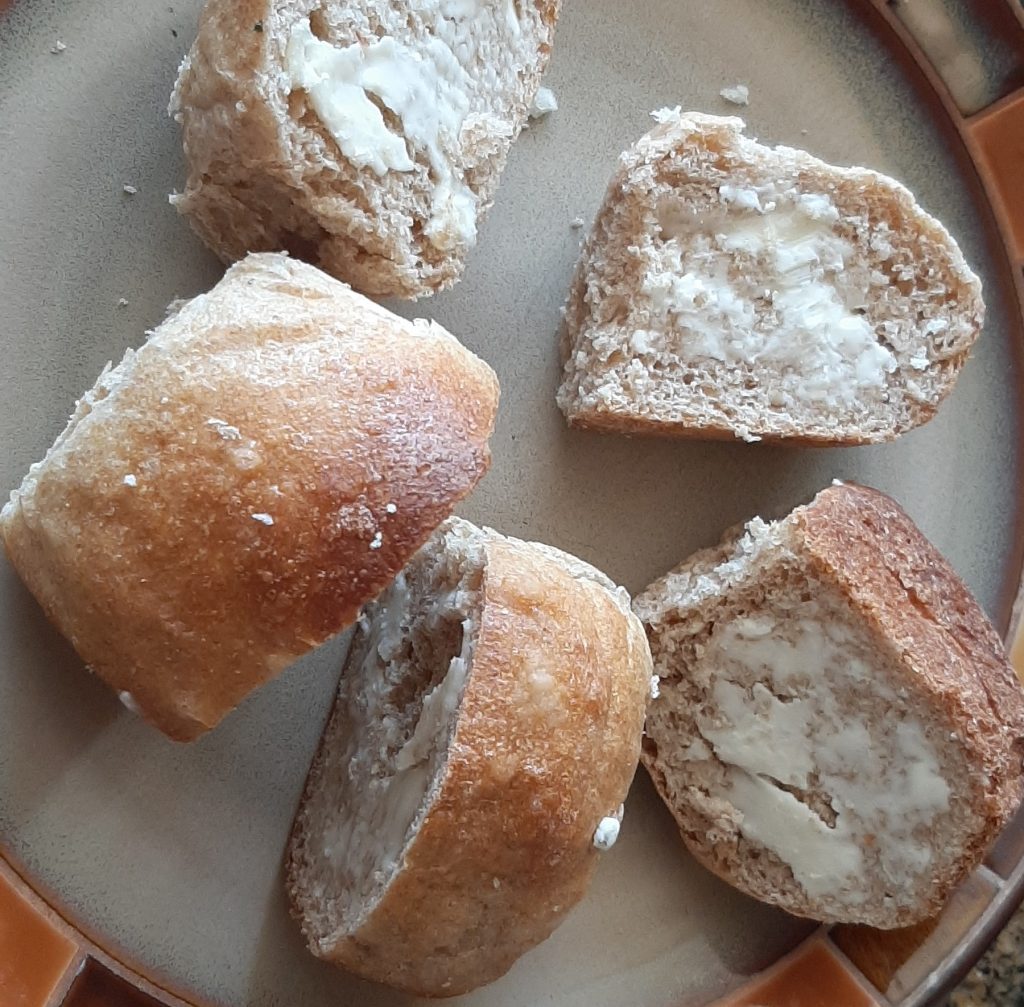
For last Sundays before concert meal in our home, to be served at exactly 1:15 pm, I prepared these whole wheat rolls and my soon to be published recipe for Savory Overnight Soft Dinner Rolls. Both offerings were well received. And the glorious thing, besides the ease of preparation and wonderful taste of both of these rolls, is that I must make and shape the rolls the day before I plan to serve them. And if you have ever made a full dinner for a large number of people, you know that every dish cannot be made the day of the event. So, every part of every dish that can be made ahead, must be made ahead. So, all I had to do Sunday morning was take the 2 9×13-inch pans out of my fridge, let them sit for about 1½ hours on the counter to come to room temperature (and perhaps rise a bit more), and then throw the pans in the oven. Done deal!
It always amazes me that people question whether I indeed made whatever type of bread I am serving. And I feel a bit bad when I have to admit that bread is just so darn easy to make. And also, so bloody forgiving. With cake, for example, you must measure the ingredients to a gnat’s eyelash. But with bread dough, you can fling just about anything into the mix, and it comes out fine.
So, as with this recipe, I added more butter than originally called for, less sugar, a tablespoon of vital wheat gluten*, and used 2 types of whole wheat flour. And the resulting dinner rolls were soft and delicious. Just enough whole wheat taste to be perfect when spread with soft butter. And as a roll to be eaten with breakfast liberally spread with either jam or honey, there is simply no equal.
So, next time you need a dinner roll that is perfect with just about any dish, give this simple recipe a try. You will not be sorry. Except of course when all the rolls have been eaten.
And as always, peace and love to all.
1 T. active dry yeast
1¼ c. warm water
¼ c. granulated sugar
6 T. melted butter, cooled to lukewarm
1 lg. egg
1½ tsp. kosher salt, plus more for sprinkling
1 T. vital wheat gluten
2 c. whole wheat flour
1¾ – 2 c. whole wheat pastry flour
veggie oil
1 egg white, beaten
In a large stand mixer fitted with a dough hook, dissolve yeast in warm water. Let sit for 5 minutes, then mix in the sugar, melted butter, egg, and salt.
With your mixer running on low, add the vital wheat gluten and the 2 cups of whole wheat flour and about a 1¾ cups of the whole wheat pastry flour. Increase speed to medium and keep mixing until dough pulls away from sides of bowl and is smooth and elastic. (If dough seems too sticky, add 1 tablespoon of flour at a time until dough pulls away from the sides of the mixing bowl.)
Add a bit of veggie oil to the bowl, and using your hands and a stiff rubber spatula, form the dough into an evenly greased ball. Cover bowl with plastic wrap and let dough rise in a warm place 1½ to 2 hours or until doubled in size.
Once dough is doubled, punch down and divide into 20 pieces. Shape each portion into a ball and place balls in a buttered 9×13-inch baking pan. Cover pan with plastic wrap and refrigerate overnight.
Remove dinner rolls from refrigerator, remove the plastic wrap, cover with a clean tea towel, and let sit on your counter for about 1½ hours. Brush with the beaten egg white and lightly sprinkled with kosher salt just before placing in the oven.
Bake rolls in a pre-heated 375-degree oven for 20-23 minutes or until golden brown. The internal temperature of the rolls when taken with an instant read thermometer should be at least 190-degrees. (And yes, with bread of any sort, I always take the internal temperature before declaring it ready to be removed from the oven!)
* Vital wheat gluten is not technically flour. But rather a flour-like powder that contains nearly all gluten and minimal starch. It is produced by hydrating wheat flour, which activates the gluten protein, and then processed to remove everything except the gluten. Afterwards it is dried and ground back into a powder.
Since vital wheat gluten is a concentrated wheat protein, just a tablespoon or two in your bread dough can improve its texture, elasticity, and create a better crumb and chewiness in the final product. Vital wheat gluten is especially helpful for bread recipes using low-protein flour varieties, such as whole wheat or rye flour. It is also good for breads containing mix-ins like nuts or fruits. Vital wheat gluten helps provide more structure and stability to the final product.
